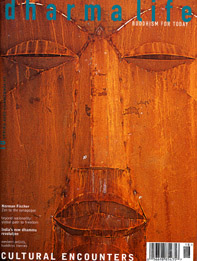Abundant Treasures
AFGHANISTAN: The fall of the Taliban regime has revived debate over the Bamiyan Buddhas, which they destroyed a year ago. A Swiss-based group New7Wonders has proposed to rebuild the larger of the two statues at an estimated cost of $1 million.
First, a computer-generated image would be developed, then a 20ft replica built that would be the model for rebuilding the full-size Buddha on location in Afghanistan. UNESCO has responded with interest, but said the decision rests with the Afghan government, which seems divided on the proposal. A team of Italian scientists has reported that rebuilding on site would be impossible and the new Buddha would have to be installed at an adjacent site
UZBEKISTAN: While archaeologists have been unable to explore Afghanistan, they have turned to neighbouring Uzbekistan, which was once part of the same Kushan Buddhist civilisation. An important focus is Termez, once the Buddhist centre of Central Asia. Huge monastery complexes extended down the Amu Darya River, the present-day border with Afghanistan, and Uzbeks, who are largely ignorant of this history, still recite prayers at Buddhist sites. Archaeologists from Japan, France and elsewhere are unearthing Buddha statuettes encased under remnants of centuries of Muslim life.
CHINA: Archaeologists have discovered two stupas and over 500 grottoes with numerous Buddha statues in a 50km strip along the Jinghe River in Northwest China's Gansu province. The grottoes are thought to have been constructed at different times during the Sixteen Kingdoms Period (317-420 CE). More than 400 of the caves, which are similar to those at the famous Dunhuang site, were once inhabited by Buddhist monks, and they may be the earliest of their kind in China.
BANGLADESH: Discovery of 2450-year-old artefacts - the most ancient yet found in Bangladesh - have revealed that the area was the eastern limit of Mauryan Empire and that Buddhism was practised there very early in its history. The remains at Wari-Bateshwar village show that the region was developed in trade and industry earlier than previously thought. Knobbed Ware pottery, exclusively identified with the practice of Buddhism, has also been found.
KARNATAKA, INDIA: Excavations at a newly discovered Buddhist site in the southern Indian state of Karnataka have revealed a stupa/temple complex that was built between the second century BCE and the second or third century CE. It is constructed of brick and richly decorated limestone slabs that depict the Buddha's life and the Buddhist Emperor Asoka's conquests. The first phase of construction took place under Hinayana influence, while later phases were Mahayana-inspired. These finds offer important insights into the dissemination and development of Buddhism in India.
NEPAL: A 2,500-year-old human skeleton was unearthed near Lumbini (the Buddha's birth-place) during the excavation of Ramgram Stupa in south-west Nepal, which contains relics of the Buddha. Coins and earthenware have enabled the skeleton to be dated and show it was a near-contemporary of the Buddha; possibly they belonged to one of Buddha's disciples. In this belief many visitors and pilgrims have travelled to the stupa to view the remains.



